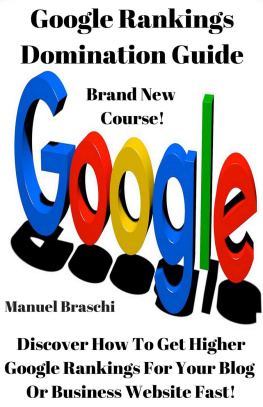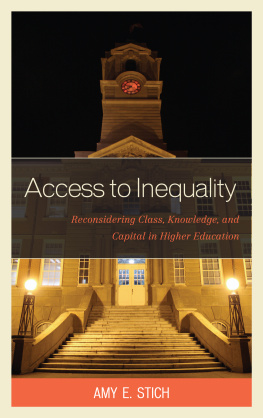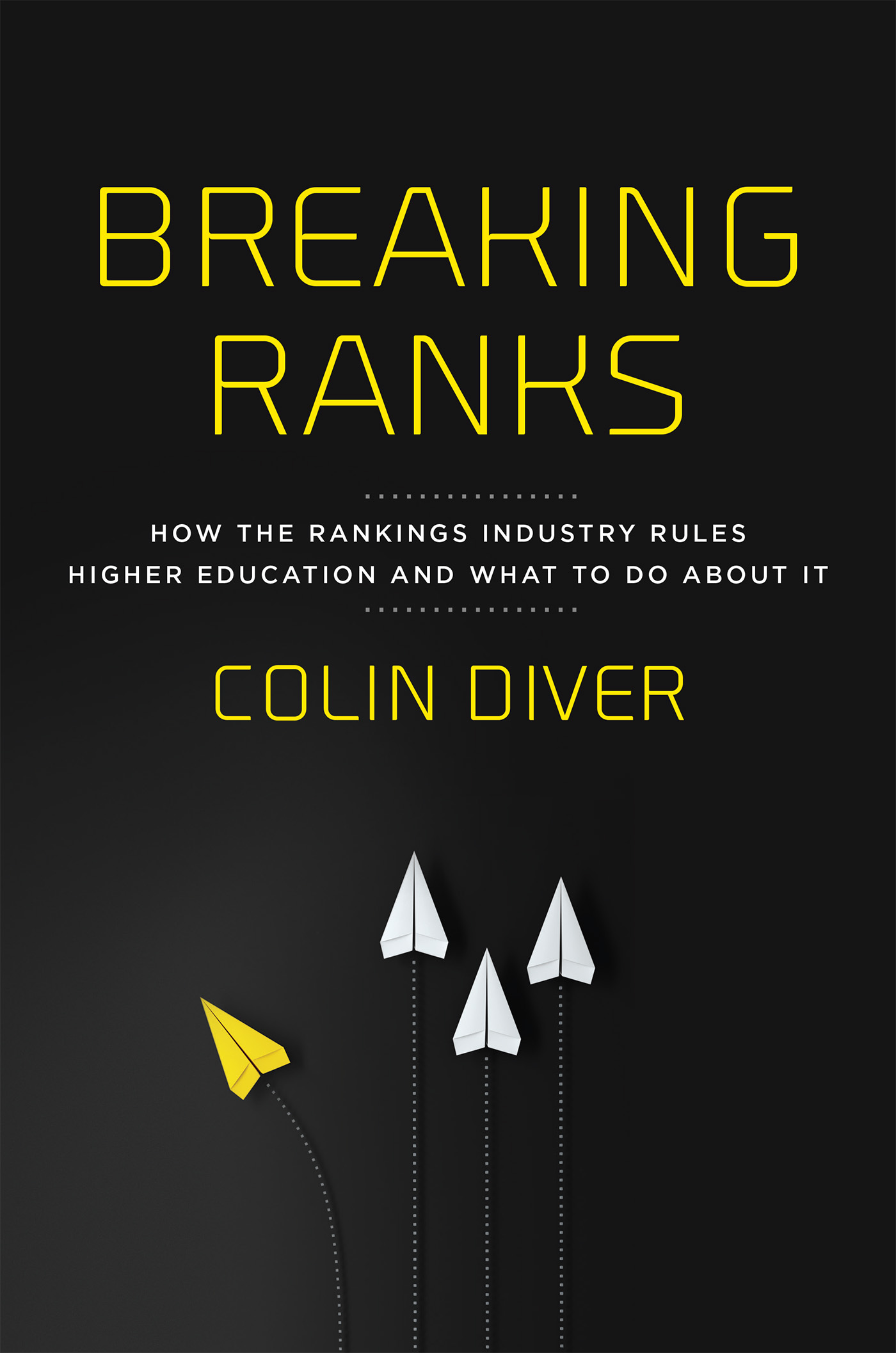BREAKING RANKS
BREAKING RANKS
...................
HOW THE RANKINGS INDUSTRY RULES HIGHER EDUCATION AND WHAT TO DO ABOUT IT
...................
COLIN DIVER

JOHNS HOPKINS UNIVERSITY PRESS
BALTIMORE
2022 Johns Hopkins University Press
All rights reserved. Published 2022
Printed in the United States of America on acid-free paper
2 4 6 8 9 7 5 3 1
Johns Hopkins University Press
2715 North Charles Street
Baltimore, Maryland 21218-4363
www.press.jhu.edu
Library of Congress Cataloging-in-Publication Data
Names: Diver, Colin S., author.
Title: Breaking ranks : how the rankings industry rules higher education
and what to do about it / Colin Diver.
Description: Baltimore : Johns Hopkins University Press, 2022. | Includes
bibliographical references and index.
Identifiers: LCCN 2021017977 | ISBN 9781421443058 (hardcover) | ISBN
9781421443065 (ebook)
Subjects: LCSH: Universities and collegesRatings and rankingsUnited
States. | Education, HigherSocial aspectsUnited States. | Education,
HigherUnited StatesEvaluation.
Classification: LCC LB2331.63 .D58 2022 | DDC 378.73dc23
LC record available at https://lccn.loc.gov/2021017977
A catalog record for this book is available from the British Library.
Special discounts are available for bulk purchases of this book.
For more information, please contact Special Sales at .
To Joan, who has taught me everything important
PREFACE
My career as law-school dean, college trustee, and college president largely coincided with the era in which college rankings emerged as a powerful force in American higher education. Like most educators, I know from firsthand experience what it is like to live under their ominous, often oppressive, shadow. But I also know what it is like to escape from their grip, thanks to my service as the president of a schoolReed Collegethat famously refused to play the game.
Those diverse experiences provide the motivation for this book. As you might expect, I am not a fan of college rankings. But this volume is not just an extended diatribe against them or a futile call for their abolition. Rather, it is a sincere effort to understand and explain, as well as critique, a phenomenon that seems to have become a permanent feature of the higher educational landscape. I utilize personal experiences as illustrations, but I draw much more heavily on the enormous body of scholarship about higher education: its market structure, its financing and operation, its inputs and outputs, and the numerous methods available for evaluating and comparing individual institutions.
Rankings have undoubtedly served useful purposes. Yet they have also seriously misled many college applicants and badly distorted the behavior of educators. In my view, their costs have outweighed their benefits, and my primary advice to both applicants and educators is to ignore them. Nonetheless, being a realist, I know that these annual best-college lists continue to exert a magnetic pull on higher education. Therefore, this book is dedicated to helping those who do pay attention to this phenomenonstudents and their families, precollege counselors, higher-education faculty and administrators, alumni, donors, public funders, government regulatorsto make the soundest possible use of the information such publications provide and to avoid falling into the traps that they so cleverly set for the unwary.
My focus in this volume is not, alas, on all of higher education but rather only on its most competitive segment. Of the 7,600 postsecondary institutions in America, only about 400 admit fewer than half of their applicants, and roughly 800 admit fewer than three-quarters. The remaining schools compose the vast ecology of non-selective institutions: two-year community colleges, for-profit institutions, some open-enrollment private nonprofits, and many non-flagship public universities.
In many ways this non-selective sector is the most important component of American higher education. For it is the schools in this segment that struggle, year in and year out, always underfunded and underappreciated, to educate Americas most academically disadvantaged students. These are the institutions attended by most low-income students, students of color, children of immigrants, working-class kids, and older adults trying to earn a degree while juggling job and family. Yet this sector is not the realm of college rankings, which are aimed almost exclusively at students who aspire to attend selective schools and who seek guidance in choosing among them.
I focus primarily on undergraduate education because it is the entry point into the world of higher education that affects by far the largest number of rankings consumers. Given my background, I also discuss legal education as a source of comparison or an illustration of general points. Nevertheless, professional and graduate schools are so diverse in character and mission that I make no attempt to survey the distinctive systems that exist to evaluate all of them.
Following a brief prologue, I have divided my presentation into four parts. The first discusses the evolution of college rankings, from beguiling curiosities and occasional scorecards of a schools performance to a veritable ruling regimewhat I sometimes call a rankocracy. presents a brief history of the college-ranking industry and a more detailed description of its current landscape. The next chapter unpacks and critiques the formulas customarily used to construct those pervasive best-college lists. The following three chapters discuss the ways in which they have gradually shaped, and often distorted, the behavior of the participants in American higher educationincluding applicants, their parents, and counselors, as well as college administrators.
covers the increasingly common view of American higher education as a means of conferring pedigree, based on the relative prestige of the school that one has attended. The following three chapters examine the uses and abuses of three common proxies deployed in an attempt to measure prestige: expert (peer) opinion, institutional wealth, and spending per student.
by interrogating the curious failure of most ranking systems to give comparable weight to different schools success in achieving racial and ethnic diversity.
In contrast to the input measures canvassed in ends with a chapter asking whether, and how, we might compare colleges by their success in preparing their graduates to live truly fulfilling lives.
In the concluding chapter, I offer advice on how both college-going applicants and educational administrators can live in a world saturated with college rankings, while avoiding being trapped in their seductive embrace.
Because this publication and others that publish comprehensive college rankings are available both online and in print, I have decided not to use the italics that traditionally identify print material.
BREAKING RANKS
PROLOGUE
On July 1, 2002, I became president of Reed College in Portland, Oregon. As I began to fill the shelves in my office with books and mementos from my previous life as a law-school dean, I could feel the weight already lifting from my shoulders. Im no longer subject to the tyranny of college rankings, I thought. I dont need to worry about some news magazine telling me what to do.








